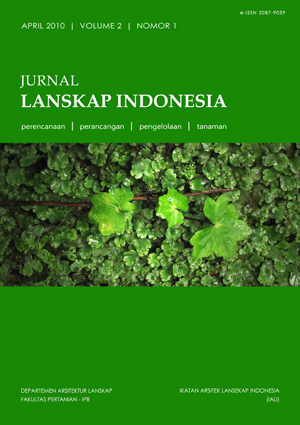EVALUASI TATA HIJAU JALAN PADA TIGA KAWASAN PEMUKIMAN BERSKALA BESAR DI KABUPATEN BOGOR, JAWA BARAT
Abstract
The main purpose of this study is to compare road greeneries by describing functional, aesthetic, and maintenance aspects of those at the settlement of Danau Bogor Raya (DBR), Bukit Sentul (BS) and Kota Wisata (KW). Another one is to propose a concept of functional, aesthetical and maintenance of road greenery. The evaluation of functional aspect are including screening, wind control, glare control, shade control, erosion control, and direction control. The aesthetic evaluation included plant selection and plant arrangement thatevaluated by 30 respondents. While the maintenance included design and technicalaspects.
The data analysis indicated differences among thosethe three settlements in plants domination with low to medium variations. The different dimension of road showed that the functional, aesthetic and maintenance aspects of them are not fully suitable with the principle of landscape architecture. In functional aspect, several problem were found such as the problem found in several, such as wind and glare controls in
DBR, and wind, glare and shade controls in BS and KW. In aesthetic, the problem found especially in plant arrangement at DBR and KW main ways. In maintenance, technical aspect at DBR and design aspect at KW are still need to be improved.
Downloads
This journal permits and encourages authors to post items submitted to the journal on personal websites or institutional repositories both prior to and after publication, while providing bibliographic details that credit, if applicable, its publication in this journal. However, after the article is submitted and published in this journal, it is fully copyrighted by the Jurnal Lanskap Indonesia or JLI. If excerpts from other copyrighted works are included, the author must obtain written permission from the copyright owner and give credit to the source in the article. Then, the writer or reader is allowed to copy, share, and redistribute articles/material in any form. But it must still include the appropriate source and credit because the article in this journal is licensed by Creative Commons Attribution 4.0 International License (CC BY 4.0).
I. Proposed Policy for Journals That Offer Open Access
Authors who publish with this journal agree to the following terms:
- Authors retain copyright and grant the journal right of first publication with the work simultaneously licensed under a Creative Commons Attribution License that allows others to share the work with an acknowledgement of the work's authorship and initial publication in this journal.
- Authors are able to enter into separate, additional contractual arrangements for the non-exclusive distribution of the journal's published version of the work (e.g., post it to an institutional repository or publish it in a book), with an acknowledgement of its initial publication in this journal.
- Authors are permitted and encouraged to post their work online (e.g., in institutional repositories or on their website) prior to and during the submission process, as it can lead to productive exchanges, as well as earlier and greater citation of published work (See The Effect of Open Access).
II. Proposed Policy for Journals That Offer Delayed Open Access
Authors who publish with this journal agree to the following terms:
- Authors retain copyright and grant the journal right of first publication, with the work after publication simultaneously licensed under a Creative Commons Attribution License that allows others to share the work with an acknowledgement of the work's authorship and initial publication in this journal.
- Authors are able to enter into separate, additional contractual arrangements for the non-exclusive distribution of the journal's published version of the work (e.g., post it to an institutional repository or publish it in a book), with an acknowledgement of its initial publication in this journal.
- Authors are permitted and encouraged to post their work online (e.g., in institutional repositories or on their website) prior to and during the submission process, as it can lead to productive exchanges, as well as earlier and greater citation of published work (See The Effect of Open Access).



























